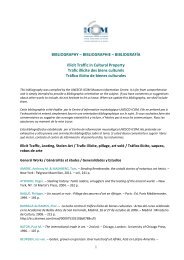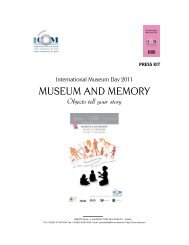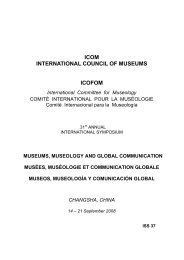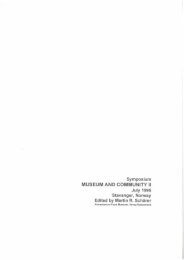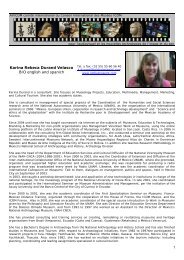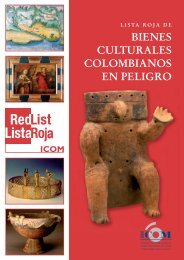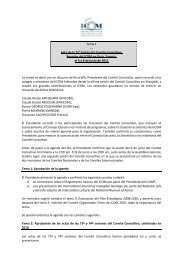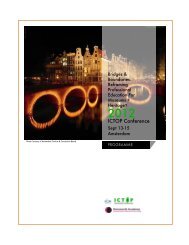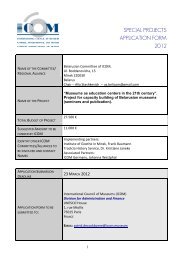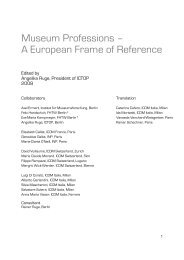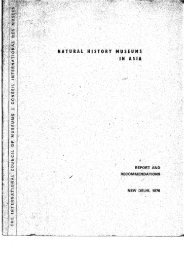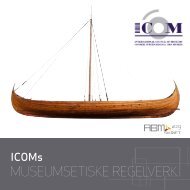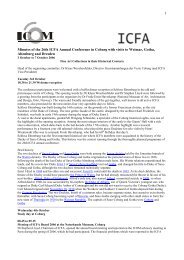Key Concepts of Museology - ICOM
Key Concepts of Museology - ICOM
Key Concepts of Museology - ICOM
Create successful ePaper yourself
Turn your PDF publications into a flip-book with our unique Google optimized e-Paper software.
The process <strong>of</strong> musealisation does<br />
not consist <strong>of</strong> taking an object to<br />
place it within the physical confi nes<br />
<strong>of</strong> the museum, as Zbyněk Stránský<br />
explains. Through the change <strong>of</strong><br />
context and the process <strong>of</strong> selection<br />
and display, the status <strong>of</strong> the object<br />
changes. Whether it is a religious<br />
object, a useful object or one for<br />
enjoyment, animal or vegetable, even<br />
something that may not be clearly<br />
conceived as an object, once inside<br />
the museum it becomes the material<br />
and intangible evidence <strong>of</strong> man<br />
and his environment and a source <strong>of</strong><br />
study and exhibition, thus acquiring<br />
a specifi c cultural reality.<br />
The recognition <strong>of</strong> this change in<br />
nature caused Stránský, in 1970, to<br />
propose the term musealia to identify<br />
objects which had undergone the<br />
process <strong>of</strong> musealisation and could<br />
thus claim the status <strong>of</strong> museum<br />
objects. The term was translated into<br />
French as muséalie (see Object).<br />
Musealisation begins with a phase<br />
<strong>of</strong> separation (Malraux, 1951) or <strong>of</strong><br />
suspension (Déotte, 1986): objects<br />
or things (real things) are separated<br />
from their original context to be studied<br />
as documents representing the<br />
reality to which they formerly belonged.<br />
A museum object is no longer<br />
an object to be used or exchanged,<br />
but now delivers authentic evidence<br />
<strong>of</strong> reality. This removal (Desvallées,<br />
1998) from reality is already an initial<br />
form <strong>of</strong> substitution. An object separated<br />
from the context from where<br />
it was taken is already no more than<br />
a substitute for the reality <strong>of</strong> which<br />
it is supposed to be evidence. This<br />
transfer, by the separation that has<br />
been made from the original environment,<br />
inevitably causes a loss <strong>of</strong><br />
information, which can be seen most<br />
clearly from illegal archaeological<br />
digs where the context <strong>of</strong> the objects<br />
has been completely lost as they were<br />
unearthed. It is for this reason that<br />
musealisation, as a scientifi c process,<br />
necessarily includes the essential<br />
museum activities: preservation<br />
(selection, acquisition, collection<br />
management, conservation), research<br />
(including cataloguing) and communication<br />
(via exhibition, publications,<br />
etc.) or, from another point<br />
<strong>of</strong> view, the activities around the<br />
selection, collection and display <strong>of</strong><br />
what has become musealia. At most,<br />
the work <strong>of</strong> musealisation gives an<br />
image which is only a substitute for<br />
the reality from which these objects<br />
were chosen. This complex substitute,<br />
or model <strong>of</strong> reality (built within<br />
the museum) comprises museality,<br />
that is to say a specifi c value which<br />
documents reality, but is in no way<br />
reality itself.<br />
Musealisation goes beyond the<br />
logic <strong>of</strong> collections alone and is part<br />
<strong>of</strong> the tradition founded on rational<br />
processes developed with the invention<br />
<strong>of</strong> modern sciences. The object<br />
carrying the information or the<br />
document-object, once musealised,<br />
is incorporated into the core <strong>of</strong> the<br />
museum’s scientifi c activity just as<br />
this has developed since the Renaissance.<br />
The purpose <strong>of</strong> this activity is<br />
to explore reality by means <strong>of</strong> sen-<br />
51



